DIAMOND DRILLING HITS THICK AND EXTENSIVE COPPER SYSTEM The distinctive mineralized horizon encountered at depth within ST23-01 and ST23-02 is interpreted to correlate with the stronger copper mineralization intersected in 2022 drill hole ST22-10. The holes are located approximately 680m apart and approximately 500m to the north of ST22-10. The large spacing between these drill holes, and scale of the gravity anomalies are strong evidence of a very large, laterally extensive copper system in the Storm Project area.
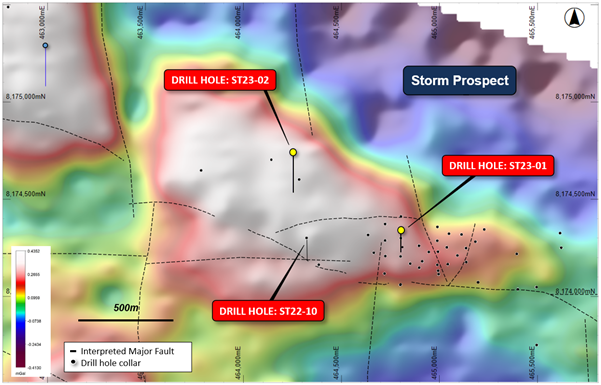
Figure 3: Total bouguer gravity image of the 4100N area, fault architecture and drill hole locations.

Visual estimates of mineral abundance should never be considered a proxy or substitute for laboratory analyses where concentrations or grades are the factors of principal economic interest. Laboratory assays are required to determine the presence and grade of any contained mineralization within the reported visual intersections of copper sulfides. Portable XRF is used as an aid in the determination of mineral type and abundance during the geological logging process.
DRILL HOLE ST23-01 DETAILS
ST23-01 was drilled to a downhole depth of 416m and intersected two main zones of visual copper mineralization (Figure 7). The drill hole was designed to test the northern extent of the high-grade 4100N Zone, and to test the large gravity anomaly at depth, below the near-surface copper mineralization.
The first zone of copper mineralization encountered within ST23-01 is located near-surface within the 4100N Zone and consists of 30.5m of breccia and fracture-hosted chalcocite and minor chalcopyrite (Figure 10) over three major intervals from 45m downhole. This mineralization is typical of the near-surface copper mineralization at the 4100N Zone and indicates that the mineralization remains open to the north.
A second zone of mineralization was intersected at 332m downhole. The mineralized interval is 15m thick and consists of mosaic breccia and replacement-style chalcopyrite cement (Figure 4). Minor sphalerite (zinc sulfide) is present within the lower part of the sequence.
The sulfides are hosted within a sequence of organic-rich and vuggy dolomudstone. The mineralized zone has a higher specific gravity than the host stratigraphy, which indicates that the drill hole has likely intersected the interpreted source of gravity anomalism.
The mineralization and stratigraphy within the deeper intercept in ST23-01 are visually very similar but contains more chaclcopyrite than the mineralization encountered within drill hole ST22-10 (see September 28, 2022 Aston Bay news release). Drill hole ST22-10 is located 500m southwest from ST23-01 and indicates that the stratigraphy is laterally extensive.
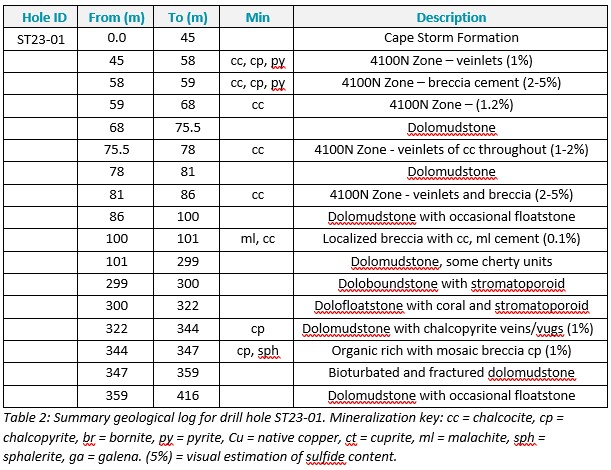
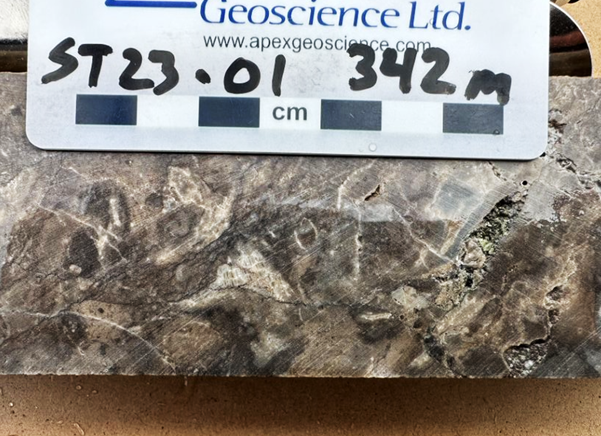
Figure 4: Chalcopyrite (brassy) in vugs and veinlets in drill hole ST23-01 from approximately 342m downhole.
DRILL HOLE ST23-02 DETAILS
Drill hole ST23-02 was drilled to a downhole depth of 602m and intersected a continuous 37m thick zone of visual copper mineralization from 333m downhole (Figure 7).
The mineralized interval is variably brecciated and fractured with chalcocite as the dominant copper sulfide mineral. The lower section of the interval contains very strong mineralization with 1-5% visual sulfide and localized breccias containing up to 30% chalcocite. Rare native copper and sphalerite (zinc sulfide) along with pyrite are present within the lower part of the mineralized sequence.
The copper mineralization is hosted within bioturbated mudstones within a broader interval of fossiliferous carbonates. The geology and mineralization are very similar to drill holes ST23-01 and ST22-10 and located at a similar depth (Figure 7). Mineralization elsewhere at Storm is zoned (chalcocite – chalcopyrite – pyrite – sphalerite/galena), so the presence of chalcocite suggests that drill hole ST23-02 is potentially vectoring to the higher-grade portions of the copper system.
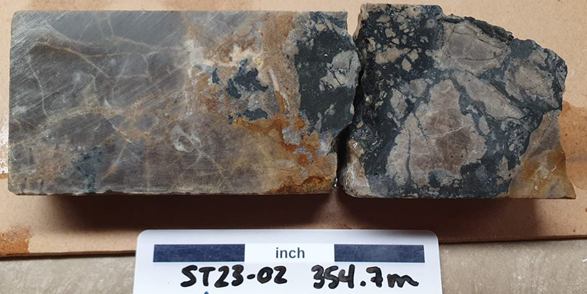
Figure 5: Chalcocite (dark grey) breccia fill in drill hole ST23-02 from approximately 354.7m downhole.
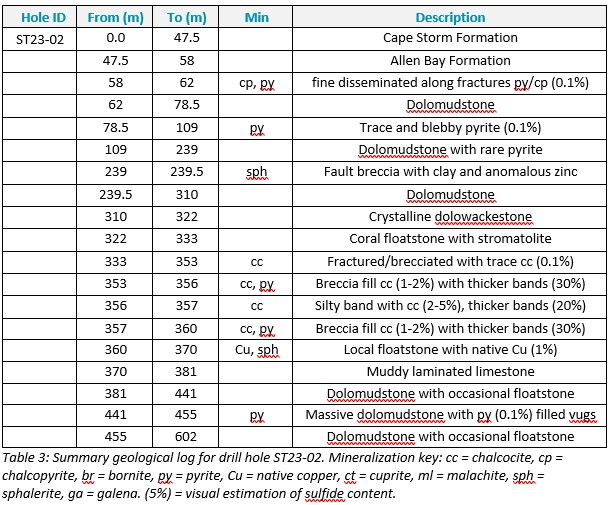
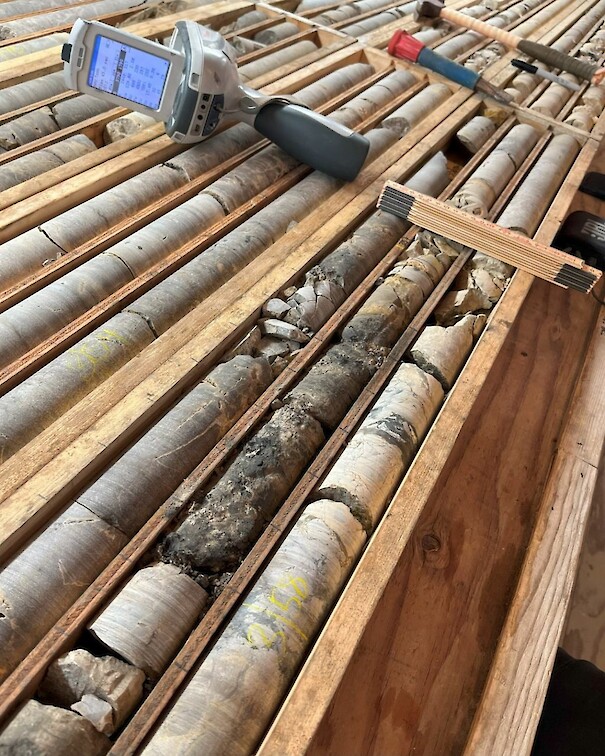
Figure 6: Chalcocite (dark grey) breccia fill in drill hole ST23-02. The interval shown is approximately 352-359m downhole.
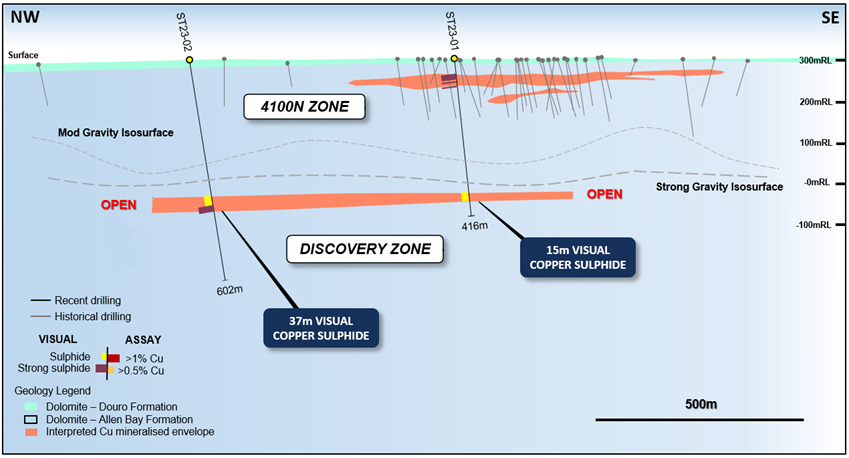
Figure 7: NW – SE long section through drill holes ST23-01 and ST23-02. The mineralized horizon is flat-lying, laterally extensive, and open.
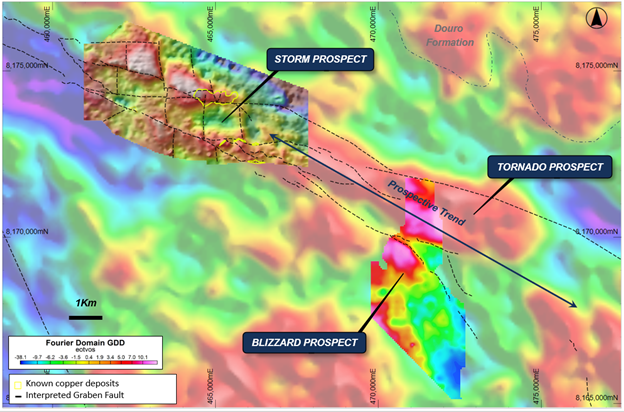
Figure 8: Map of the Storm and Tornado/Blizzard areas showing the ground gravity survey data over Storm (2023 survey)
and Tornado/Blizzard (2015 survey), overlaying the property-scale airborne gravity gradiometry survey data (2017 Falcon Survey).
EXTENSIVE COPPER SYSTEM AT STORM
The copper mineralization and geology within drill holes ST23-01, ST23-02 and ST22-10 are highly similar and suggest that the stratigraphy of the mineralized system is laterally very extensive. The geometry of the host package is interpreted to be relatively flat-lying and predictable, with thick sequences of altered sediments comprised of dolomudstone and carbonate rocks.
The geology of the mineralized sequence displays all the elements required in the sediment-hosted mineralization process which include permeable carbonate rocks to act as a fluid conduit and host to mineralization, hydrocarbons to reduce metal-bearing fluids and force metal precipitation, a sulfur source from bitumen and sour gas, and a favourable structural setting to act as a plumbing system for metal-bearing fluids.
The metal and minerals show distinct zonation with a large copper-rich core (chalcocite, bornite and covellite) that gives way laterally and vertically to thinner peripheral zones of copper-iron (chalcopyrite), iron (pyrite), zinc (sphalerite) and minor lead (galena).
The Storm area shows clear similarities to many of the world’s major sediment-hosted copper systems, including the deposits of the Kalahari Copper Belt (Botswana) and Central African Copper Belt (DRC, Zambia). These copper deposits typically have metre scale thicknesses and kilometre scale strikes of the mineralized zones.
A series of extensive gravity, EM and IP anomalies have been defined underneath the near-surface copper mineralization in the Storm area. The three drill holes completed to date targeted only one of the gravity features, with most of the larger system remaining untested. These gravity targets cover an area of over 7.5 km2, giving significant potential for the Storm area to host a world-class scale copper system.
The regional potential continues outside of the Storm area, with airborne gravity targets (Falcon Survey) that can be traced over 10km to the east along the graben and into the Tornado/Blizzard Prospects, where copper is exposed at the surface (Figure 8).
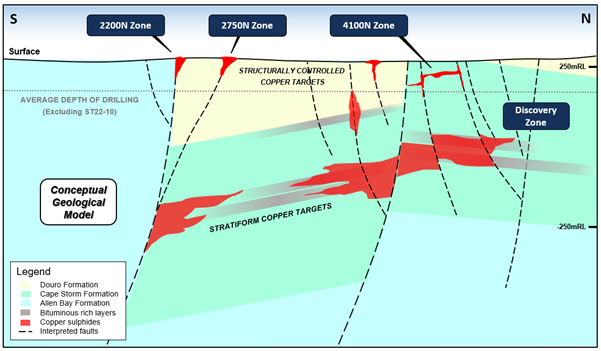
Figure 9: Conceptual geological and exploration targeting model for the Storm Project, showing depth of current drilling and conceptual copper system at depth.
PLANNED PROGRAM
- The diamond drilling continues to test key geophysical and geological copper targets in the Storm area. The third exploration drill hole is underway and is collared approximately 1.7km south of ST23-02, and 1km west of the high-grade 2750N Zone. The hole is testing a large gravity anomaly and EM conductor in an area with limited previous drilling. Initial assays for the diamond drilling are expected in the next 4 weeks.
- The Reserve Circulation (RC) drilling is continuing in the Storm area with the results from the 2750N and 2200N Zones expected shortly. Drilling will also focus on expansion of the 4100N Zone and testing several new, near-surface copper targets. Initial assays are expected in the next 2-3 weeks.
- Sorting, beneficiation and process optimization continues on a range of mineralization styles.
- An environmental baseline survey will begin in mid-August 2023.
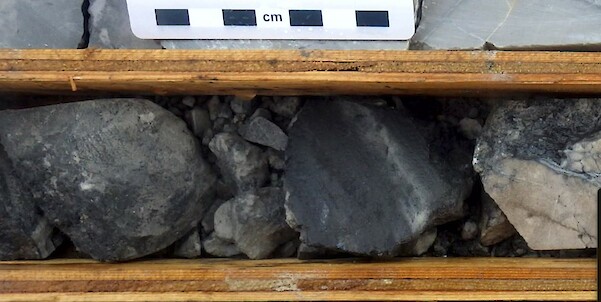
Figure 10: Chalcocite (metallic and dark grey) breccia in drill hole ST23-01 from the 4100N Zone. The interval shown is approximately 58m downhole.
About the Storm Copper and Seal Zinc-Silver Projects, Nunavut
The Nunavut property consists of 173 contiguous mining claims covering an area of approximately 219,257 hectares on Somerset Island, Nunavut, Canada. The Storm Project comprises both the Storm Copper Project, a high-grade sediment-hosted copper discovery (intersections including 110m* @ 2.45% Cu from surface and 56.3m* @3.07% Cu from 12.2m) as well as the Seal Zinc Deposit (intersections including 14.4m* @ 10.58% Zn, 28.7g/t Ag from 51.8m and 22.3m* @ 23% Zn, 5.1g/t Ag from 101.5m). Additionally, there are numerous underexplored and undrilled targets within the 120-kilometre strike length of the mineralized trend, including the Tornado copper prospect where 10 grab samples yielded >1% Cu up to 32% Cu in gossans.
Storm Discovery and Historical Work
High-grade copper mineralization was discovered at Storm in the mid-1990s by Cominco geologists conducting regional zinc exploration around their then-producing Polaris lead-zinc mine. A massive chalcocite boulder found in a tributary of the Aston River in 1996 was traced to impressive surface exposures of broken chalcocite mineralization at the surface for hundreds of metres strike length at what became named the 2750N, 2200N, and 3500N Zones. Subsequent seasons of prospecting, geophysics and over 9,000 m of drilling into the early 2000s confirmed a significant amount of copper mineralization below the surface exposures as well as making the blind discovery of the 4100N Zone, a large area of copper mineralization with no surface exposure.
Following the merger of Cominco with Teck in 2001 and the closure of the Polaris Mine, the Storm claims were allowed to lapse in 2007. Commander Resources re-staked the property in 2008 and flew a helicopter-borne VTEM survey in 2011 but conducted no additional drilling. Aston Bay subsequently entered into an earn-in agreement with Commander and consolidated 100% ownership in 2015. Commander retains a 0.875% Gross Overriding Royalty in the area of the original Storm claims.
In 2016 Aston Bay entered into an earn-in agreement with BHP, who conducted a 2,000-station soil sampling program and drilled 1,951m of core in 12 diamond drill holes, yielding up to 16m* @ 3.1% Cu. BHP exited the agreement in 2017. Aston Bay conducted a property-wide airborne gravity gradiometry survey in 2017 and drilled 2,913m in nine core holes in the Storm area in 2018 yielding a best intercept of 1.5m* @ 4.39% Cu and 20.5m* @ 0.56% Cu.